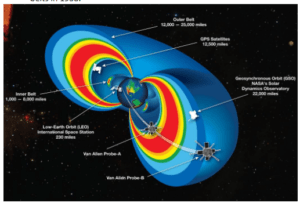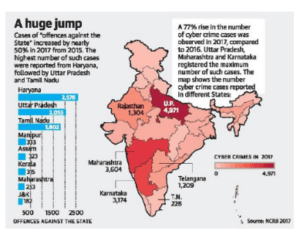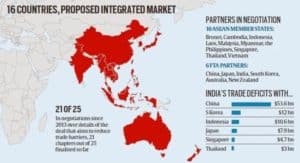IASbaba's Daily Current Affairs Analysis
IAS UPSC Prelims and Mains Exam – 23rd October 2019
Archives
(PRELIMS + MAINS FOCUS)
2019 ozone hole is the smallest on record
Part of: GS Prelims and GS Mains III–Environment
In News
- The ozone hole over Antarctica is the smallest observed since 1982, due to abnormally warm temperatures in the upper atmosphere that dramatically limited ozone depletion in September and October this year, according to NASA
- Ozone is a molecule that is composed of three oxygen atoms. It is responsible for filtering out harmful ultraviolet radiation from the Sun.
- The gas is constantly being made and destroyed in the stratosphere, about 20-30km above the Earth.
- In an unpolluted atmosphere, this cycle of production and decomposition is in equilibrium. But chlorine and bromine-containing chemicals released by human activity have unbalanced the process, resulting in a loss of ozone that is at its greatest in the Antarctic spring in September/October.
- Nearly 200 countries agreed to ban the chemicals most damaging to the ozone under the Montreal Protocol of 1987.
Ramgarh dam
Part of: GS Prelims and GS Mains III –Environment Conservation
In News
- An agitation for protection of catchment area of the historic Ramgarh dam , once considered the lifeline of Jaipur, has revived with the villagers and farmers of the region staging a sit-in near the dam demanding immediate removal of encroachments.
- Its construction was completed in 1904 during the reign of erstwhile Jaipur ruler Sawai Madho Singh II.
- The dam, which earlier supplied drinking water to the city, has dried completely in the last decade
- There is a suggestion that the Chambal river water be supplied to the dam through the proposed Eastern Rajasthan Canal Project so as to revive the dam
Rise in stubble burning cases in Punjab
Part of: GS Prelims and GS Mains III – Environment Conservation
In News
- Over 3,300 cases reported till October 21 as against 2,564 incidents in corresponding period last year
- Stubble burning, close to the autumn season every year, has been a key contributing factor of pollution in the air and breathing problems among people across the northern region, including New Delhi
- The reason behind the higher number of fire cases has been the decision to advance the date of paddy sowing this season, a week earlier than the scheduled date of June 20 due to early arrival of monsoon this year.
- Consequently, harvesting of the crop has also started early this time. And because of this, the number of farm fires this year, as against the corresponding period last year, is higher.
- For management of paddy straw without burning, the Centre and the State government are providing subsidised agro-machines and equipment to farmers and cooperative societies. Yet farmers continue to burn crop residue claiming lack of alternatives.
- The ban and action against people burning crop residue is regulated under the Air (Prevention and Control of Pollution) Act, 1981.
- In 2016, Punjab witnessed 84,000 incidents of stubble fire while in 2017, a dip was seen with the number of cases at 46,000. In 2018, the fire incidents were close to 50,000, according to the government data.
Hover-taxis
Part of: GS Prelims and GS Mains III – Infrastructure
In News
- German firm Volocopter tests its battery-operated, two-seater heli-taxi vehicle in Singapore
- The 18 propeller vehicle— resembling small helicopters but powered by drone-like technology — can fly autonomously but there was a pilot aboard during the test for safety reasons.
- Earlier in October 2019, Volocopter unveiled the “VoloPort”, a flying taxi port at the Singapore’s Marina Bay with a landing and takeoff pad as well as a passenger terminal.
- Many Asian mega-cities are notorious for monster traffic jams, which leave millions of commuters facing long journeys, and can delay executives trying to dash to airports or reach important meetings on time.
- Volocopter says that such innovation in air transport is going to reduce traffic congestion and revolutionize urban mobility
Freedom of Press
Part of: GS Prelims and GS Mains II –Polity
In News
- On 21st Oct 2019, Australian newspaper readers had an unexpected experience — no matter which paper they picked up, the front page carried text that was blacked out — as if it had been redacted by the government.
- The decision to ‘censor’ the front page was carried out by a media coalition across print, TV, radio and online portals, called the “Right to Know”
- Australia’s Right to Know coalition includes Nine, News Corp, the ABC, SBS, The Guardian, and journalists’ union the Media, Entertainment and Arts Alliance.
- The move was in response to the progressive hardening of national security laws over the past two decades by successive governments that have not only undermined investigative journalism but also criminalised it
- A central demand of the Right to Know coalition is that the government exempts journalists and whistleblowers from a counter-espionage law that was introduced last year
Van Allen Probes mission
Part of: GS Prelims and GS Mains III –Science & Technology
In News
- NASA recently decommissioned its 7-year-old Van Allen Probes mission.
- It comprised of two satellites that were placed in Van Allen belts which studied how these radiation rings acquire and lose electromagnetic particles
- Understanding space weather is important as it interferes with our on-ground power grids, navigation communications satellites in orbit and health of astronauts
- Both the satellites will exist in the orbit for approximately 15 years during which they are going to slowly come towards the atmosphere and get destroyed in the orbit.
- Van Allen radiation belts are giant swaths of magnetically trapped, highly energetic charged particles that surround earth.
- James Van Allen, a physicist at the University of Iowa, discovered these radiation belts in 1958.

Daily Current Affairs IAS | UPSC Prelims and Mains Exam – 23rd October 2019
(MAINS FOCUS)
CRIME
TOPIC: General Studies 3:
- Challenges to internal security through communication networks, role of media and social networking sites in internal security challenges, basics of cyber security; money-laundering and its prevention
- Security challenges and their management in border areas; linkages of organized crime with terrorism
- Various Security forces and agencies and their mandate
Crime in India report
Context
- The 2017 Crime in India report, released by the National Crime Records Bureau (NCRB),
- 30% jump in cases recorded as “offences against the State
- For the first time, the NCRB has introduced categories of cyber crimes against women and children.
- The NCRB has also recorded cases of disproportionate assets against public servants besides introducing new crime heads such as abetment, criminal intimidation, simple hurt, credit/debit card and online frauds, Internet crimes through online gaming and kidnapping for begging among others.

Daily Current Affairs IAS | UPSC Prelims and Mains Exam – 23rd October 2019
Facts:
Crime against SC /ST
- More than half of all offences registered under The Scheduled Castes and the Scheduled Tribes (Prevention of Atrocities) Act where victims were Dalits, were related to insult and humiliation heaped on them.(Karnataka, UP and Bihar)
- The highest rates of crimes against Dalits (number of incidents per 1,00,000 population) were in Madhya Pradesh (52), Bihar (41), and Rajasthan (35).
Corruption:
- A new trend in cases of corruption: “traps” involving lower-level government officials are increasing at the cost of criminal misconduct involving senior officials. (This could mean either reduced corruption at higher levels, or increased enthusiasm among law enforcement to go after small offenders)
- Registration of corruption cases has fallen by over 20% since 2015. “Trap” cases have spiked.
- “Trap” cases, in which bribery is caught red-handed, generally involve lower-level officials who accept gratification in cash. Criminal misconduct cases generally involve higher officials; pecuniary gains in these case are rarely made in cash.
Cyber crime:
- The number of cyber crimes increased dramatically in 2017 as compared to 2016,
- Nearly every fifth cyber crime in 2017 was committed against a woman.
- More than half the incidents of cyber crime in 2017 were motivated by fraud
- The number of cyber crimes committed per 1,00,000 population — in 2017 was 1.7, the report shows.
- The most cyber crimes per 1,00,000 population were committed in Karnataka 5% in 2017; Telangana was next, with a rate of 3.3%, followed by Maharashtra (3) and Uttar Pradesh (2.2%)
- UP, the most populous state, registered the largest number of cyber crimes
- The cyber crimes against women were related to cyber blackmail or threats, cyber pornography or hosting or publishing obscene sexual materials, cyber stalking or cyber bullying of women, defamation, or morphing and indecent representation of women, etc
Crime against women and children:
- In the case of women and children, the NCRB has this time recorded data for “murder with rape”.
- In 2017, as many as 33,885 women were reported to have been raped across the country. Of these, 227 were murdered after the rape.
- As many as 28,152 children were raped with cases registered under IPC and the POCSO Act. Of these, 151 were killed after being raped.
- Majority of juveniles in conflict with law apprehended under IPC and SLL crimes were in the age group of 16 years to 18 years.

Daily Current Affairs IAS | UPSC Prelims and Mains Exam – 23rd October 2019
Img: https://indiatribune.com/wp-content/uploads/2019/10/Crime.jpg
Justice:
- Police delayed charge sheets in 40% of cases.
- In certain cases such as rioting, which includes communal riots, police delayed filing of chargesheets in 60% of the cases(90 days as per law).
- There are more than 3 lakh cases pending investigations for more than one year.
- 40% of cases in fast-track courts have taken more than three years to finish the trial
- 3,384 cases committed to fast-track courts, the trial was finished in more than 10 years.
- 2,71,779 cases were pending trial at the end of 2017.(In total)
Criticism:
- The report omits data on mob lynchings, khap killings, murder by influential people and killings for religious reasons.
- Data on farmer suicides after 2015 not published.
Do you know?
- The National Crime Records Bureau (NCRB), is an Indian government agency responsible for collecting and analysing crime data as defined by the Indian Penal Code (IPC) and Special and Local Laws (SLL).
- Part of the Ministry of Home Affairs (MHA), Government of India.
- It was set up based on the recommendation of the Task force,1985 and National Police Commission,1977 by merging the Directorate of Coordination and Police Computer (DCPC), Inter State Criminals Data Branch of CBI and Central Finger Print Bureau of CBI
Conclusion:
- The NCRB data on crime hide significant variances in case registration of serious crimes such as rapes and violence against women across States, which make it difficult to draw State-wise comparisons.
Connecting the dots:
- The 2017 report shows that the States in the northeast and others in the rest of the country with a significant tribal population (Jharkhand, Chhattisgarh, Odisha) have relatively higher murder rates and this is a cause of worry. Analyse
TRADE
TOPIC: General Studies 2:
- Bilateral, regional and global groupings and agreements involving India and/or affecting India’s interests
- Effect of policies and politics of developed and developing countries on India’s interests, Indian Diaspora.
Eighth Regional Comprehensive Economic Partnership (RCEP) ministerial meeting
Context:
- Commerce Minister Piyush Goyal is in Bangkok for the eighth Regional Comprehensive Economic Partnership (RCEP) ministerial meeting.
- The meeting, which is likely to be the last one at this level, is expected to work out the unresolved issues in the negotiations on the mega trade deal that is to be concluded later this year.
RCEP:
- The Regional Comprehensive Economic Partnership (RCEP) is a trade deal that is currently under negotiation among 16 countries — the 10 member countries of the Association of Southeast Asian Nations (ASEAN), and the six countries with which the ASEAN bloc has free trade agreements (FTA).
- The ASEAN, which includes Brunei, Cambodia, Indonesia, Laos, Malaysia, Myanmar, the Philippines, Singapore, Thailand, and Vietnam, has FTAs with India, Australia, China, South Korea, Japan and New Zealand.

Img: https://images.indianexpress.com/2019/10/rcep.jpg?w=759&h=413&imflag=true
Purpose:
- The purpose of RCEP is to create an “integrated market” spanning all 16 countries, making it easier for products and services of each of these countries to be available across this region.
- ASEAN says the deal will provide “a framework aimed at lowering trade barriers and securing improved market access for goods and services for businesses in the region”.
- The negotiations are focussed on areas like trade in goods and services, investment, economic and technical cooperation, intellectual property, competition, dispute settlement, e-commerce, and small and medium enterprises.
Milk issue of India:
- Milk is the India’s largest “crop”.
- In 2018-19, the estimated production of milk, at 187.75 million tonnes (mt).
- The value of milk output (Rs 5,63,250 crore at an average farm-gate rate of Rs 30/kg)
- Milk is a source of liquidity for farmers, as it is sold daily and generates cash to take care of routine household expenses, unlike other crops that are marketed only once or twice a year.
Concern:
- Milk matters equally to consumers in India, because it meets the animal protein/fat requirements of a significant portion of the population that is vegetarian.
- As incomes rise, the demand for milk goes up even more.
- If dairy products are covered under an RCEP deal, India may have to allow members of the bloc greater access to its market, whether through phased duty reductions or more liberal tariff rate quotas (TRQs).
- There is an already existing TRQ for milk powder, which enables import of up to 10,000 tonnes per year at 15% customs duty, and quantities beyond that at the regular rate of 60%.
- The Indian dairy industry is resisting any enhanced TRQs or other import concessions, even if extended only to RCEP countries, as opposed to the US or European Union.
Other Issues:
- India’s trade deficits with nations have always widened after signing free-trade-agreements (FTAs) with them, citing the cases with ASEAN, Japan, Korea, and Singapore, most of which are RCEP nations.
- It has also been pointed out that India’s vulnerable agriculture and dairy sectors, which are not in positions to compete with Australia and New Zealand, will be exposed to vagaries of global trade.
- Indian manufacturing is not competitive enough to face the vagaries of a free trade regime.
- Even after 27 years of liberalisation, inefficiency prevails due to a host of unimplemented reforms in the product and the factor markets.
- On the factor side, labour market reforms are incomplete. Labour productivity in manufacturing is still one of the lowest in the world with spatially fragmented labour laws are escalating the costs of doing business.
Given this, Indian industry is hardly in a position to compete in the level-playing ground in a free-trade region.
Way forward
- Despite all the concerns, the government must take into account that either slowing down India’s RCEP engagement or walking out of the talks at this stage would cut India out of the rules-making process for the RCEP and give China further space in the regional trade and security architecture.
- At a time when the U.S. has broken from the global consensus on multilateral trade agreements, an Indian walkout would endanger the united message that RCEP countries, which represent 40% of the global GDP, would wish to send out.
- It would also be a sharp departure from India’s “Act East” slogan and its extended outreach to ASEAN.
Conclusion:
- RCEP could perhaps end up doing to dairy what the free trade agreement with the Association of Southeast Asian Nations (ASEAN) did in palm oil, fear many in the industry in India.
- At a time of global uncertainties and challenges to multilateralism and the international economic order, a negative message on RCEP would undermine India’s plans for economic growth.
Connecting the dots:
- India cannot afford to fall out of the free trade agreement negotiations. Analyse
(TEST YOUR KNOWLEDGE)
Model questions: (You can now post your answers in comment section)
Note:
- Featured Comments and comments Up-voted by IASbaba are the “correct answers”.
- IASbaba App users – Team IASbaba will provide correct answers in comment section. Kindly refer to it and update your answers.
Q.1)Van Allen beltsometimes seen in the news is related to which of the following?
- Belt of volcanoes surrounding Pacific Ocean
- Belt of asteroids between Mars and Jupiter
- Magnetic belt surrounding Earth
- None of the above
Q.2)Ramgarh Damsometimes seen in news is located in which state ?
- Uttar Pradesh
- Uttarakhand
- Rajasthan
- Gujarat
Q.3)Consider the following statements
- Ozone is a molecule that is composed of three oxygen atoms. It is responsible for filtering out harmful ultraviolet radiation from the Sun.
- The gas is constantly being made and destroyed in the stratosphere, about 20-30km above the Earth.
- Nearly 200 countries agreed to ban the chemicals most damaging to the ozone under the Paris Protocol of 2015.
Which of the statement(s) given above is/are correct?
- 1 and 2 only
- 2 and 3 only
- 1 and 3 only
- 1,2 and 3
MUST READ
Can China break shackles of its old economic systems, scale greater heights?
Should Indian Railways move towards a market-oriented allocation of train paths?
Leaving the door open to a border settlement
Asia’s remarkable economic transformation
Firm steps to ease the fiscal federalism tension











